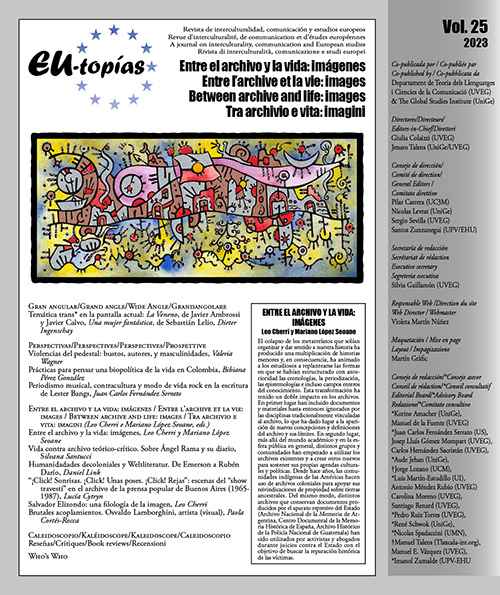Brutal Hook-up. Osvaldo Lamborghini, (visual) artist
DOI:
https://doi.org/10.7203/eutopias.25.26089Keywords:
Archive, new materialisms, authorship, residuality, visual turn. Abstract
Abstract
In the 80s, Osvaldo Lamborghini produced what could be called his “visual work”: drawings made with markers, pens and other school supplies, exquisite collages made with out-of-date pornographic publications, plasters composed of dubious materials. The Teatro proletario de cámara and the “objectual” work (cigarette cases, boxes, notebook covers that he later used a little, until he got bored and moved on to the next) dates from these years. His passion for the materiality of the signifier and the literality that palpitates in his writing finds a new path in this task that occupies him during his last years in Barcelona. This essay addresses this production, with the conviction that this archive composed by images and objects does not reveal an anecdotal and parallel task, but a brutal hook-up between writing and visuality that refocuses Lamborghini’s poetics within the framework of the expanded field opened by the avant-garde of the second part of the 20th century.
 Downloads
Downloads
 References
References
Aira, César. “Las dos fórmulas”. El sexo que habla. Osvaldo Lamborghini. Catálogo a cargo de Sara Plasencia. Barcelona: MACBA, 2015, pp. 23-28.
Buchloh, Benjamin. “Atlas/Archive”. The Optic of Walter Benjamin. Ed. Alex Coles. vol. III. Londres: Black Dog Publishing Limited, 1999, pp. 27-48.
Foucault, Michel. La arqueología del saber. Traducción de Aurelio Garzón del Camino. Buenos Aires: Siglo XXI, 1999 [1969].
Boris Groys. Volverse público: las transformaciones del arte en el ágora contemporánea. Traducción de Paola Cortes Rocca. Buenos Aires: Caja Negra, 2014.
Chejfec, Sergio. “De la inasible catadura de Osvaldo Lamborghini”. Babel. Revista de libros, 10, 1989, p. 21.
Hernández, José. Martín Fierro. Buenos Aires: Kapelusz, 1980 [1872].
Laddaga, Reinaldo. Espectáculos de realidad. Rosario: Beatriz Viterbo, 2007.
Lamborghini, Osvaldo. Novelas y cuentos. Barcelona: Ediciones del Serbal, 1988.
— Osvaldo Lamborghini Inédito. Edición a cargo de Néstor Colón y Agustina Pérez. Buenos Aires: Lamás Médula, 2019.
— OLn. Traducción de Ben Bollig (inglés), Hannes Sättele (alemán), Guillaume Contré (francés), Raul Schenardi (italiano) y Ariadna García (portugués). Prólogo y coordinación de Agustina Pérez. Buenos Aires: Fadel & Fadel, 2020.
Masotta, Oscar. “Yo cometí un happening”. Happenings. Buenos Aires: Jorge Álvarez, 1967.
Mitchell, W.J.T. “Mostrando el ver. Una crítica de la cultura visual”. Estudios visuales, 1, 2003 [2000], pp. 17-40. Traducción de Pedro Cruz Sánchez.
Nancy, Jean-Luc. La comunidad desobrada. Tradución de Pablo Perera. Madrid: Arena libros, 2001.
Nazar, Mariana, y Pak Linares, Andrés. “El hilo de Ariadna”. Políticas de la memoria, 6/7, 2006, pp. 212-18.
Pauls, Alan. “El problema Bellatin”. El interpretador. Literatura, arte y pensamiento, 20, abril, 2005.
— “Pornoliteral”. El sexo que habla. Osvaldo Lamborghini. Barcelona: MACBA, 2015, pp. 107-152.
Pérez, Agustina. La retombée de la materialidad en la obra de Osvaldo Lamborghini (1969-1985): lo escrito, lo visual, lo objetual. Tesis de doctorado en Teoría comparada de las artes. Buenos Aires, Universidad Nacional de Tres de febrero, 2022.
Preciado, Beatriz [Paul]. “Encamados”. El sexo que habla. Osvaldo Lamborghini. Barcelona: MACBA, 2015, pp. 153-164.
Strafacce, Ricardo. Osvaldo Lamborghini, una biografía. Buenos Aires: Mansalva, 2008.
Downloads
Published
How to Cite
-
Abstract212
-
PDF (Español)119
Issue
Section
License
![]()
The authors conserve the copyright. All content published in EU-topías. Journal of interculturality, Communication, and European Studies are subject to the license Creative Commons Attribution-NonCommercial-ShareAlike 4.0 license. The full text of the license can be found at <http://creativecommons.org/licenses/by-nc-sa/4.0>
They may be copied, used, disseminated, transmitted and publicly displayed, provided that:
- The authorship and original source of the publication is cited (journal, publisher and URL of the work).
- They are not used for commercial purposes.
- The existence and specifications of this license of use are mentioned.
It is the responsibility of the authors to obtain the necessary permissions for images that are subject to copyright.



